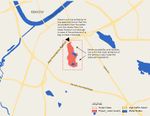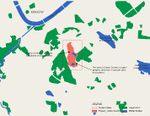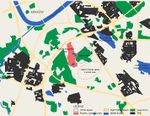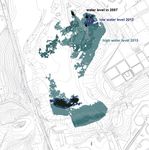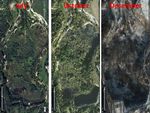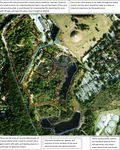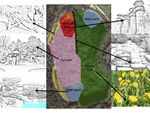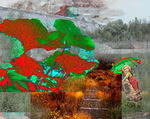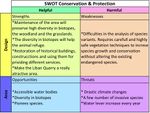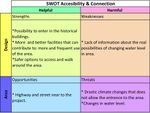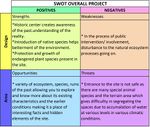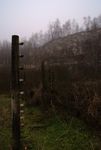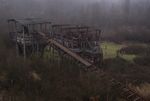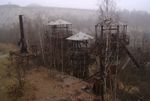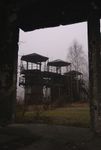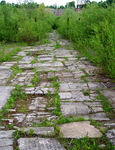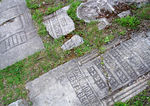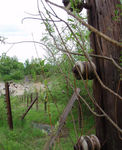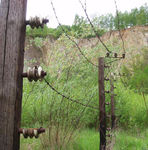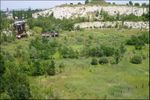Collaborative Design Planting Design Working Group 27: Difference between revisions
| (75 intermediate revisions by 4 users not shown) | |||
| Line 34: | Line 34: | ||
== Landscape and/or urban context of your case == | == Landscape and/or urban context of your case == | ||
The Liban Quarry is one of the most forgotten places in Kraków, this place is remembered for the victims of the Nazi labor camp that operated there during Kraków’s occupation (World War II); within the time The Liban Quarry become slowly a nature sanctuary for waterfowl, birds of prey, pheasants and other creatures. | The Liban Quarry is one of the most forgotten places in Kraków[http://www.28dayslater.co.uk/forums/european-international-sites/76107-liban-quarry-krak%F3w-poland-november-2012-a.html], this place is remembered for the victims of the Nazi labor camp that operated there during Kraków’s occupation (World War II); within the time The Liban Quarry become slowly a nature sanctuary for waterfowl, birds of prey, pheasants and other creatures. [http://www.flickr.com/photos/sbell/sets/72157618790136658/] | ||
The landscape of the place contains incredible limestone cliffs, ponds and dense vegetation. | The landscape of the place contains incredible limestone cliffs, ponds and dense vegetation. | ||
''' | '''HISTORY''' | ||
'''1873'''_The limestone company 'Liban and Ehrenpreis,' run by two well known Jewish industrial families from Podgórze established a quarry. | '''1873'''_The limestone company 'Liban and Ehrenpreis,' run by two well known Jewish industrial families from Podgórze established a quarry. | ||
''' | '''End of the 19th century''' _ a complex of buildings was established within the quarry and a railway line. | ||
'''1942-1944'''_ Nazi occupation, in which a penal camp, where 800 young Poles were prisoners and forced to perform hard labors, was set-up. | '''1942-1944'''_ Nazi occupation, in which a penal camp, where 800 young Poles were prisoners and forced to perform hard labors, was set-up. | ||
'''1993'''_ Steven Spielberg used Liban as the set of all the scenes from Schindler's List that take place in the Płaszów concentration camp. The Liban Quarry, the site of | '''1945'''_The evidence of Concentration Camps were erased by SS. | ||
'''1993'''_ Steven Spielberg used Liban as the set of all the scenes from Schindler's List that take place in the Płaszów concentration camp. | |||
'''Today'''_ There are still villas used by high-rank commandeers (for ex. 'Red house'), paths and roads patterns that gives a clear idea of where the camp was situated. | |||
'''BIOGEOGRAPHY''' | |||
The area of Liban Quarry is a geographic area rich in species and ecosystems: | |||
• The site is highly rich in biotopes. | |||
• The area serves as a refuge for water birds. | |||
• Highly diverse in plant species. | |||
• Provide habitat for many insects, birds and small mammals. | |||
• Woodlands are mainly formed by broad-leaved species. | |||
• Xerothermic grasslands characterize the site and are of great value. | |||
• There are some negative tendencies, like spreading of invasive species or overgrowing xerothermic grasslands with bushes. | |||
== What are the objectives of your design? == | == What are the objectives of your design? == | ||
'' | |||
'''''Objective 1''''' | |||
Liban Quarry has a long and creepy history for it with many elements and spaces which still reflect what took place years back. In my point of view I would like to say that this area with abundant plant species grown like a forest with remains of the towers and pathways and presently lot of species too should be redesigned in such a way that we preserve the existing ruins and control the growth of the plants with required access by the public so that they also will be able to know the past of this area without altering the present atmosphere of the Site. As in it should be made as a place of historical importance and should me made as a biospere reserve. | |||
'''''Objective 2''''' | |||
Today the Liban Quarry is a peaceful place; famous for the buildings and places that reminds historical terrific facts, rich diverse vegetation and also works as a refuge different kind of animals. Since we are talking about an example that has different points of view, I decided propose diverse objectives: | |||
'''Objective A: Conservation and Protection''' | |||
• The highly number of biotypes, the woodland and the grasslands must be protected in order to preserve the nature that nowadays has the place and also continue with the offer of refuge for animals. | |||
• It is important to restore the old building that can tell the history of the terrible facts that happened there. | |||
'''Objective B: Accessibility and Connection''' | |||
To the historical buildings though different ways that make easier the route. | |||
'''Objective C: Information and Orientation''' | |||
The lack of information and orientation must to be improving, inside and outside of the place, though different medias that orientates the public of what can they find or do in the Liban Quarry. | |||
'''''Objective 3''''' | |||
• This area historical importance as well as ecological importance because of rare plants and animals. So, history needs to be preserved for the future generation as well as the nature too, but slight redesign of the area can prove Liban Quarry to be a place which has all in one (nature, history, entertainment and adventure). | |||
== Analytical drawings == | == Analytical drawings == | ||
<gallery caption="Analytical Drawings " widths="150px" heights="150px" perrow=" | |||
Image: | <gallery caption="Analytical Drawings " widths="150px" heights="150px" perrow="3"> | ||
Image: | Image:AnalysisStreetsLibanQuarry.jpg|Layers: High Speed Streets, entrance, water bodies, project. | ||
Image: | Image:AnalysisVegetationLibanQuarry.jpg|Layers: Vegetation, water bodies, project. | ||
Image: | Image:AnalysisGeneralLibanQuarry.jpg|Layers: All the layers together, also built plan and special areas. | ||
Image:Analytical-il.jpg|Change in water level through years | |||
Image:Change Detection_Project Area.jpg|Change in vegetation phenology through years | |||
Image:WaterAccessibilitySpreading.jpg|Layers: Water, accessibility and spreading plants. | |||
Image:Analytical drawing-S.jpg|Vegetation and distribution inside of the project. | |||
</gallery> | </gallery> | ||
'''Water and Entrance''' | |||
The accessibility is related to the changes in the level of the water that may change within 1m, in spring for example, the melting snow make that the level of the water change extremely and make the area less accessible. | |||
Is really interesting that there is not only seasonal water level change but also in time (Change in water level through years), there was almost now water, so with each year the water area has been increasing. | |||
'''Vegetation''' | |||
It is important to know that there are no invasive species in quarry, there are pioneer species (Plants with higher ability to survive in more extreme conditions and thus take first disturbed areas like quarries and they create base for different plants to come later). The invasive species are Black Locust, Ash-leaf Maple, Solidago that are growing in dry years, thus water limit their spreading in quarry. | |||
'''Biodiversity''' | |||
The Liban quarry is isolated from other wetlands especially ones that have higher biodiversity (because of typography, urban environment, traffic lines and others), also, there are some bird species that stay in this area, so they contribute to changes in species in some extent (for ex. Bittern that is one under protection). | |||
== Projective drawings == | == Projective drawings == | ||
<gallery caption="Projective Drawings " widths="150px" heights="150px" perrow=" | |||
Image: | <gallery caption="Projective Drawings " widths="150px" heights="150px" perrow="3"> | ||
Image: | Image:Projective drawing-S.jpg|Futuristic Plans for the site | ||
Image: | Image:Analytical_Hari.jpg|Projective redesign of Liban Quarry | ||
Image: | Image:Vision.jpg|Conservation & Protection | ||
Image:Accessibility&Connection.jpg|Accessibility & Connection | |||
Image:Information&Orientation.jpg|Information & Orientation | |||
Image:Introduction of plants on different levels.jpg|Introduction of plants in different levels | |||
</gallery> | </gallery> | ||
The Project area "Liban Quarry" has its historical and cultural importance. Redesigning of this area for the public as a historical park need to take care of its past history and also target people of different age and mentality. So i thought to redesign this area into 1) Historical park 2) Natural Park 3) Fun Park 4) Water world 5) Rock climbing area and 6) Road. | |||
Historical Park: This area was used for the production of quicklime. Still existing lime klins (towers) revels the history that this place was used for lime extraction for long time even before and after World war. | |||
Natural Park: Being unused for long time,Liban Quarry have grown into a peaceful spot which protects endangered wild flowers, rare Lizards and the marshy land. | |||
Fun park: Parts of this Quarry can be used as fun park, keeping in mind not to disturb the Natural park which lies just adjacent to it. This area will provide enough space for children to play during their visit to this historical area. | |||
Water World: Some part of North and South are covered by water almost through the year. This area can be used for water world with lot of adventure. | |||
Rock climbing: The lime walls which were left unextracted or heavily extracted can be used for rock climbing. | |||
Road: The tombstone road which was reconstructed for the "Schindler's List" movie can be left as it is. | |||
== Design Synthesis == | == Design Synthesis == | ||
<gallery caption="Design Synthesis Drawings" widths="150px" heights="150px" perrow=" | <gallery caption="Design Synthesis Drawings" widths="150px" heights="150px" perrow="3"> | ||
Image: | Image:Swot_Conservation.jpg|SWOT_Conservation & Protection | ||
Image:Swot_Accesibility.jpg|SWOT_Accesibility & Connection | |||
Image: | Image:Swot_Overall.jpg|SWOT_Overall Project | ||
Image: | |||
</gallery> | </gallery> | ||
== Summary of the collaborative process == | == Summary of the collaborative process == | ||
The sight lies in overgrown abandon today, slowly becoming a nature sanctuary for waterfowl, birds of prey, pheasants and other various creatures as the city seems to have forgotten it completely. Incredible limestone cliffs, ponds and dense vegetation are as breath-taking as the rusting refinery equipment, fence posts, gravestones and tangles of barbed wire that can still be found amongst the brush here. | |||
The collaborative design process helps to analyse various nook and corner of the project with different perspectives from each person in the group. This project mainly has brought about the importance of a historically influential abandoned site which has a wide variety of flora and fauna which has been totally ignored. This process emphasizes on environmental aspects and the cultural aspects of the site in various angles.Thus by improving the present conditions of the site, the flora and fauna of the place will move to a different level of diversity. | |||
== Image Gallery == | == Image Gallery == | ||
<gallery caption="Image Gallery" widths="150px" heights="150px" perrow="4"> | <gallery caption="Image Gallery" widths="150px" heights="150px" perrow="4"> | ||
Image: | Image:L1.jpg|Corridor between the inner and outer fences in winter. | ||
Image: | Image:L2.jpg|Kamieniołom Liban (Quarry) | ||
Image: | Image:L3.jpg|Watchtowers & barracks with genuine historical structures. | ||
Image: | Image:L4.jpg|Watchtowers & barracks with genuine historical structures. | ||
Image:L5.jpg|The reconstructed road of tombstones, it is not real. | |||
Image:L6.jpg|Detail of the reconstructed road of tombstones (look carefully for the repetitions). | |||
Image:L7.jpg|Corridor between the inner and outer fences in summer | |||
Image:L8.jpg|Another view of the fence posts and barbed wire in summer. | |||
Image:Quarry 1943.jpg|Quarry in 1943. | |||
Image:Quarry 2004.jpg|Quarry in 2004. | |||
Image:Jewish cemeteries.jpg|Jewish Cemeteries. | |||
</gallery> | </gallery> | ||
== References == | == References == | ||
1. http://www.inyourpocket.com/poland/krakow/sightseeing/Podgorze-Places-of-Interest/Liban-Quarry_49806v | 1. http://www.inyourpocket.com/poland/krakow/sightseeing/Podgorze-Places-of-Interest/Liban-Quarry_49806v | ||
2. http://prezi.com/ttywkthagqmz/part-i-brief-survey-and-analysis/?utm_campaign=share&utm_medium=copy by Ilona Feklistova | |||
3. http://www.flickr.com/photos/sbell/sets/72157618790136658/ | |||
4. http://www.28dayslater.co.uk/forums/european-international-sites/76107-liban-quarry-krak%F3w-poland-november-2012-a.html | |||
5. http://polandian.wordpress.com/2008/05/12/schindlers-list-death-camp-krakow-off-the-beaten-track/ | |||
6. http://media-cdn.tripadvisor.com/media/photo-s/01/0c/68/1d/waterworld-great-day.jpg | |||
7. http://www.climbing-photography.co.uk/blog/index.php/2011/climbing-photography-tips/ | |||
8. http://brentwood.thefuntimesguide.com/2007/07/new_brentwood_park_owlcreek.php | |||
9. http://www.corvallisadvocate.com/2013/0516-may-18-weed-tutorial/ | |||
Latest revision as of 15:04, 29 January 2014
---> back to group page working group 27
Liban Quarry, Krakow-Poland
| Name | Liban Quarry | |
| Location | Krakow | |
| Country | Poland | |
| Authors | Ilona Feklistova,Saranya Gunasekaran, Luisa Colorado,Hari Adhikari | |

| ||
|
| ||
Landscape and/or urban context of your case
The Liban Quarry is one of the most forgotten places in Kraków[1], this place is remembered for the victims of the Nazi labor camp that operated there during Kraków’s occupation (World War II); within the time The Liban Quarry become slowly a nature sanctuary for waterfowl, birds of prey, pheasants and other creatures. [2]
The landscape of the place contains incredible limestone cliffs, ponds and dense vegetation.
HISTORY
1873_The limestone company 'Liban and Ehrenpreis,' run by two well known Jewish industrial families from Podgórze established a quarry.
End of the 19th century _ a complex of buildings was established within the quarry and a railway line.
1942-1944_ Nazi occupation, in which a penal camp, where 800 young Poles were prisoners and forced to perform hard labors, was set-up.
1945_The evidence of Concentration Camps were erased by SS.
1993_ Steven Spielberg used Liban as the set of all the scenes from Schindler's List that take place in the Płaszów concentration camp.
Today_ There are still villas used by high-rank commandeers (for ex. 'Red house'), paths and roads patterns that gives a clear idea of where the camp was situated.
BIOGEOGRAPHY
The area of Liban Quarry is a geographic area rich in species and ecosystems:
• The site is highly rich in biotopes.
• The area serves as a refuge for water birds.
• Highly diverse in plant species.
• Provide habitat for many insects, birds and small mammals.
• Woodlands are mainly formed by broad-leaved species.
• Xerothermic grasslands characterize the site and are of great value.
• There are some negative tendencies, like spreading of invasive species or overgrowing xerothermic grasslands with bushes.
What are the objectives of your design?
Objective 1
Liban Quarry has a long and creepy history for it with many elements and spaces which still reflect what took place years back. In my point of view I would like to say that this area with abundant plant species grown like a forest with remains of the towers and pathways and presently lot of species too should be redesigned in such a way that we preserve the existing ruins and control the growth of the plants with required access by the public so that they also will be able to know the past of this area without altering the present atmosphere of the Site. As in it should be made as a place of historical importance and should me made as a biospere reserve.
Objective 2
Today the Liban Quarry is a peaceful place; famous for the buildings and places that reminds historical terrific facts, rich diverse vegetation and also works as a refuge different kind of animals. Since we are talking about an example that has different points of view, I decided propose diverse objectives:
Objective A: Conservation and Protection
• The highly number of biotypes, the woodland and the grasslands must be protected in order to preserve the nature that nowadays has the place and also continue with the offer of refuge for animals.
• It is important to restore the old building that can tell the history of the terrible facts that happened there.
Objective B: Accessibility and Connection
To the historical buildings though different ways that make easier the route.
Objective C: Information and Orientation
The lack of information and orientation must to be improving, inside and outside of the place, though different medias that orientates the public of what can they find or do in the Liban Quarry.
Objective 3
• This area historical importance as well as ecological importance because of rare plants and animals. So, history needs to be preserved for the future generation as well as the nature too, but slight redesign of the area can prove Liban Quarry to be a place which has all in one (nature, history, entertainment and adventure).
Analytical drawings
- Analytical Drawings
Water and Entrance
The accessibility is related to the changes in the level of the water that may change within 1m, in spring for example, the melting snow make that the level of the water change extremely and make the area less accessible.
Is really interesting that there is not only seasonal water level change but also in time (Change in water level through years), there was almost now water, so with each year the water area has been increasing.
Vegetation
It is important to know that there are no invasive species in quarry, there are pioneer species (Plants with higher ability to survive in more extreme conditions and thus take first disturbed areas like quarries and they create base for different plants to come later). The invasive species are Black Locust, Ash-leaf Maple, Solidago that are growing in dry years, thus water limit their spreading in quarry.
Biodiversity
The Liban quarry is isolated from other wetlands especially ones that have higher biodiversity (because of typography, urban environment, traffic lines and others), also, there are some bird species that stay in this area, so they contribute to changes in species in some extent (for ex. Bittern that is one under protection).
Projective drawings
- Projective Drawings
The Project area "Liban Quarry" has its historical and cultural importance. Redesigning of this area for the public as a historical park need to take care of its past history and also target people of different age and mentality. So i thought to redesign this area into 1) Historical park 2) Natural Park 3) Fun Park 4) Water world 5) Rock climbing area and 6) Road. Historical Park: This area was used for the production of quicklime. Still existing lime klins (towers) revels the history that this place was used for lime extraction for long time even before and after World war. Natural Park: Being unused for long time,Liban Quarry have grown into a peaceful spot which protects endangered wild flowers, rare Lizards and the marshy land. Fun park: Parts of this Quarry can be used as fun park, keeping in mind not to disturb the Natural park which lies just adjacent to it. This area will provide enough space for children to play during their visit to this historical area. Water World: Some part of North and South are covered by water almost through the year. This area can be used for water world with lot of adventure. Rock climbing: The lime walls which were left unextracted or heavily extracted can be used for rock climbing. Road: The tombstone road which was reconstructed for the "Schindler's List" movie can be left as it is.
Design Synthesis
- Design Synthesis Drawings
Summary of the collaborative process
The sight lies in overgrown abandon today, slowly becoming a nature sanctuary for waterfowl, birds of prey, pheasants and other various creatures as the city seems to have forgotten it completely. Incredible limestone cliffs, ponds and dense vegetation are as breath-taking as the rusting refinery equipment, fence posts, gravestones and tangles of barbed wire that can still be found amongst the brush here.
The collaborative design process helps to analyse various nook and corner of the project with different perspectives from each person in the group. This project mainly has brought about the importance of a historically influential abandoned site which has a wide variety of flora and fauna which has been totally ignored. This process emphasizes on environmental aspects and the cultural aspects of the site in various angles.Thus by improving the present conditions of the site, the flora and fauna of the place will move to a different level of diversity.
Image Gallery
- Image Gallery
References
2. http://prezi.com/ttywkthagqmz/part-i-brief-survey-and-analysis/?utm_campaign=share&utm_medium=copy by Ilona Feklistova
3. http://www.flickr.com/photos/sbell/sets/72157618790136658/
5. http://polandian.wordpress.com/2008/05/12/schindlers-list-death-camp-krakow-off-the-beaten-track/
6. http://media-cdn.tripadvisor.com/media/photo-s/01/0c/68/1d/waterworld-great-day.jpg
7. http://www.climbing-photography.co.uk/blog/index.php/2011/climbing-photography-tips/
8. http://brentwood.thefuntimesguide.com/2007/07/new_brentwood_park_owlcreek.php
9. http://www.corvallisadvocate.com/2013/0516-may-18-weed-tutorial/
About categories: You can add more categories with this tag: "", add your categories
